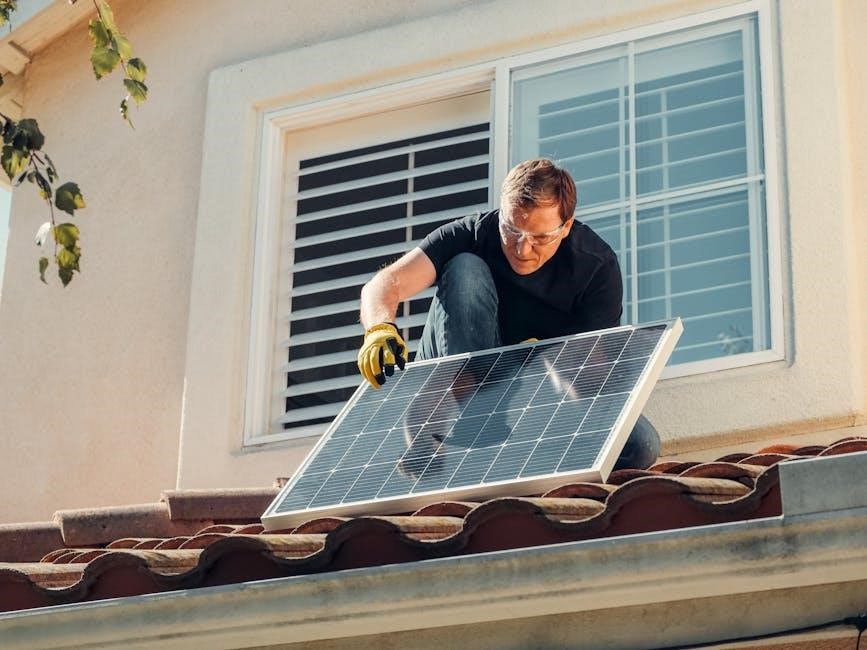colorbond roof sheet installation guide
Colorbond roof sheet installation is a popular choice for durable, weather-resistant roofing. Made from pre-painted steel, it offers long-lasting protection against rain, hail, and rust. Its fire-resistant properties and sleek designs make it ideal for modern homes. Available in various colors, Colorbond roofing enhances curb appeal while providing structural integrity.
1.1 Overview of Colorbond Roofing
Colorbond roofing is a durable, pre-painted steel material widely used for residential and commercial buildings. It consists of a zinc-aluminum alloy base coated with a corrosion-resistant primer and a baked-on paint finish. Known for its weather-tightness and longevity, Colorbond roofing is resistant to rust, fading, and pests. Its lightweight yet strong design makes it easy to install and adaptable to various roof styles. Available in multiple colors, it enhances both functionality and aesthetics, making it a popular choice for modern construction projects.
1.2 Benefits of Using Colorbond Roof Sheets
Colorbond roof sheets offer exceptional durability, resistance to weathering, and low maintenance. They are fire-resistant, termite-proof, and withstand harsh climatic conditions. Their pre-painted finish ensures long-lasting color retention and a sleek appearance. Lightweight yet strong, they reduce structural load while providing excellent insulation. Additionally, they are environmentally friendly, made from recyclable materials. These benefits make Colorbond roof sheets a cost-effective and sustainable choice for modern roofing solutions, ensuring long-term protection and aesthetic appeal for any building.

Tools and Materials Required
Essential tools include a tape measure, marker, utility knife, drill, and screwdriver. Materials needed are Colorbond roof sheets, fasteners, sarking, and flashing. Safety gear like gloves and goggles is also necessary. Ensure all items are compatible with Colorbond steel to prevent corrosion and ensure a secure installation. Proper tools and materials are crucial for a successful and durable roofing project.
2.1 Essential Tools for Installation
The essential tools for Colorbond roof sheet installation include a tape measure, marker, utility knife, drill, screwdriver, and metal shears. Safety gear like gloves, safety glasses, and a harness is also necessary. A spirit level ensures proper alignment, while a pencil marks cutting lines. Power saws or angle grinders may be needed for precise cuts. These tools enable accurate measurements, secure fastening, and safe handling of materials, ensuring a professional-grade installation. Proper tools are vital for efficiency and quality.
2.2 Required Materials for the Project
The materials needed for Colorbond roof installation include Colorbond steel sheets, roofing fasteners, sarking, and flashing. Weatherproof sealants and silicone are essential for sealing joints and valleys. Clips and brackets may be required for specific profiles. Ensure all materials comply with AS 1562.1 standards. Proper materials selection ensures durability, weather resistance, and compliance with local building codes. Always verify compatibility and quality to achieve a long-lasting, weather-tight roof installation.

Safety Precautions
Always wear protective gear, including gloves, safety glasses, and a hard hat. Ensure the ladder is stable and the workspace is clear of debris. Follow manufacturer guidelines and use proper tools to avoid accidents.
3.1 Safety Measures Before Starting
Before starting the installation, conduct a thorough inspection of the site. Ensure all tools and materials are in good condition. Clear the area of debris and obstacles to prevent tripping hazards. Check the weather forecast to avoid working in rain or strong winds. Ensure proper lighting and ventilation are available. Verify that all safety equipment, such as harnesses and hard hats, are on hand and in use. Secure the ladder firmly and ensure it is positioned on level ground. Review the manufacturer’s guidelines and safety protocols to avoid potential risks during the installation process.
3.2 Protective Gear and Equipment
Wear essential protective gear, including a safety harness, gloves, and a hard hat. Use safety glasses to protect eyes from debris. Ensure sturdy, slip-resistant footwear is worn. A dust mask is recommended when cutting or drilling. Ladder safety equipment, such as ladder levelers, should be used. Regularly inspect all gear for damage or wear. Ensure proper fitting and secure fastening of equipment to maintain safety throughout the installation process. This protective gear is crucial for preventing injuries and ensuring a safe working environment.

Site Preparation
Inspect the roof structure for damage or rot and ensure it is sturdy. Clear debris, branches, and obstacles to create a safe workspace. Organize materials and tools nearby. Ensure proper alignment of roof sheets with wind direction for optimal installation. Securely store unused materials to prevent damage or theft. A well-prepared site ensures a smooth and efficient installation process.
4.1 Checking the Roof Structure
Inspect the roof structure for damage, rot, or decay. Ensure trusses and rafters are secure and level. Check for any sagging or unevenness, which may require repairs. Verify that the structure can support the weight of Colorbond sheets. Address any issues like loose fasteners or weakened beams. A sturdy base is essential for a successful installation. If unsure, consult a professional to guarantee the roof’s integrity before proceeding with the installation process.
4.2 Clearing the Area
Clear the roof and surrounding areas of debris, old roofing materials, and vegetation. Remove any obstructions to ensure unimpeded access for installation. Cover sensitive surfaces like gardens or outdoor furniture to protect them from dust and debris. Ensure the workspace is free from tripping hazards and secure the site to prevent accidents. Proper clearance ensures a smooth and efficient installation process, allowing workers to focus on laying the Colorbond roof sheets without delays or safety risks.

Installing Roof Sarking
Roof sarking is a reflective foil laminate installed beneath Colorbond roof sheets. It provides insulation, reduces noise, and prevents moisture damage. Lay it evenly before placing the roof sheets to ensure optimal performance and protection.
5.1 What is Sarking?
Sarking is a reflective foil laminate or roof blanket installed under Colorbond roof sheets. It acts as a barrier, providing insulation, reducing noise from rain, and preventing moisture buildup. Made from durable materials, sarking protects the roof structure from weather-related damage and enhances energy efficiency. Proper installation ensures long-lasting performance and maintains the integrity of the roofing system.
5.2 How to Lay Sarking Properly
To lay sarking correctly, start by ensuring the roof structure is clear of debris. Begin at the eaves, rolling the sarking upward, and secure it with staples or screws. Ensure a tight fit, avoiding wrinkles or sagging. Overlap sheets by at least 100mm, sealing with tape for weatherproofing. Avoid gaps to prevent moisture ingress. Align sarking edges with roof trusses for even installation. Follow manufacturer guidelines for fastening and overlaps to ensure optimal performance and durability.

Laying Colorbond Roof Sheets
Align Colorbond sheets with the wind direction to ensure proper water flow. Mark and cut sheets for hips and valleys using power tools or metal shears.
6.1 Aligning Sheets with Wind Direction
Properly align Colorbond roof sheets with the prevailing wind direction to ensure water flows uniformly without pooling. This prevents leaks and extends roof life. Always lap sheets in the direction of wind flow, following manufacturer guidelines. Secure sheets tightly to avoid gaps, ensuring a seamless installation. Proper alignment enhances durability and maintains the structural integrity of the roof, providing long-term protection against weather elements.
6.2 Cutting Sheets for Hips and Valleys
Cutting Colorbond roof sheets for hips and valleys requires precision to ensure proper fitment. Use a power saw or metal shears for clean cuts. Measure and mark the sheets accurately, considering the roof’s slope and design. Avoid uneven edges, as they can lead to leaks or structural issues. Apply protective coatings to cut edges to prevent rust. Ensure cuts align with roof features, and secure sheets firmly to maintain integrity and weatherproofing. Proper cutting ensures a seamless installation and long-lasting performance.

Securing the Roof Sheets
Secure Colorbond roof sheets using high-quality fasteners, ensuring proper spacing to prevent damage. Tighten firmly but avoid over-tightening, which can damage the material or lead to leaks.
7.1 Using Fasteners Effectively
Use high-quality, corrosion-resistant fasteners specifically designed for Colorbond roofing. Ensure they are compatible with the steel to prevent reactions. Drive fasteners at the recommended spacing and angle to avoid damaging the sheets. Over-tightening can cause deformation, while under-tightening may lead to loose sheets. Always follow the manufacturer’s guidelines for fastener type and installation to ensure a secure and weather-tight seal. Proper fastening is critical for durability and performance in various weather conditions.
7.2 Ensuring Proper Sheet Alignment
Proper alignment of Colorbond roof sheets is essential for a seamless and durable installation. Ensure sheets are laid in the correct direction, considering wind patterns and roof slope. Use a chalk line or laser guide to maintain straight lines. Align each sheet with the roof structure and adjacent sheets, ensuring even spacing and no gaps. Double-check the alignment before securing to prevent misfits. Proper alignment enhances water runoff efficiency and maintains the roof’s structural integrity, ensuring long-term performance and aesthetic appeal.
Flashing and Sealing
Flashing and sealing are critical for preventing water infiltration at roof intersections. Properly install flashing at valleys, eaves, and sidewalls, ensuring watertight joints and overlaps for long-term durability.
8.1 Importance of Flashing
Flashing is essential for preventing water leaks at roof intersections, such as valleys, eaves, and sidewalls. It directs water away from vulnerable areas, protecting the structure from moisture damage and rot. Properly installed flashing ensures long-term durability and maintains the integrity of the Colorbond roof, preventing costly repairs. It also helps in reducing the risk of rust and corrosion, especially in areas prone to heavy rainfall or harsh weather conditions.
8.2 Sealing Valleys and Joints
Sealing valleys and joints is critical to prevent water ingress and ensure a watertight roof. Using high-quality sealants or flashing materials, these areas must be tightly closed to avoid leaks. Proper alignment and secure fastening of Colorbond sheets are essential to maintain the seal; Regular inspections and maintenance can help identify gaps or wear, ensuring the roof remains protected against weather conditions and extends its lifespan. This step is vital for maintaining the structural integrity and aesthetic appeal of the roof.

Common Mistakes to Avoid
Ensure proper alignment and sufficient fastening to prevent leaks and structural issues. Avoid improper sealing of valleys and joints, which can lead to water ingress and damage.
9.1 Improper Alignment
Improper alignment is a common mistake during Colorbond roof sheet installation. Misaligned sheets can lead to water ingress, reduced structural integrity, and accelerated wear. Ensure sheets are evenly spaced and securely fastened, following the manufacturer’s guidelines. Uneven surfaces or incorrect lap joints can compromise the roof’s performance. Proper alignment ensures a watertight seal and maintains the roof’s aesthetic appeal. Always measure carefully and use appropriate tools to achieve precise fitting, preventing long-term damage and costly repairs.
9.2 Insufficient Fastening
Insufficient fastening is another critical error that can compromise the integrity of a Colorbond roof. If sheets are not securely fastened, they may lift in strong winds or leak over time. Properly tightening fasteners ensures the roof remains watertight and stable. Over-tightening can damage the sheets, while under-tightening risks loosening. Always follow the manufacturer’s guidelines for the correct torque and spacing of fasteners. Neglecting this step can lead to costly repairs and reduce the roof’s lifespan significantly. Attention to detail is essential for a durable and weather-tight installation;
Best Practices for Installation
Adhere to manufacturer guidelines for Colorbond roof sheet installation to ensure durability and weather-tightness. Proper fastening techniques and regular inspections are crucial for maintaining structural integrity and longevity.
10.1 Following Manufacturer Guidelines
Following manufacturer guidelines ensures a professional and durable installation. Always use approved fasteners and safety equipment to prevent damage or injury. Proper handling techniques prevent scratches or dents to the Colorbond sheets. Ensure all cuts are made with appropriate tools to maintain material integrity. Regular inspections during installation help identify and address issues promptly. Adhering to the recommended installation methods guarantees the warranty and long-term performance of the roof. This approach minimizes risks and enhances the overall quality of the roofing system.
10.2 Regular Inspections
Regular inspections are crucial for maintaining the integrity of your Colorbond roof. Check for loose fasteners, dents, or rust, and ensure all flashing and joints are sealed. Inspect valleys for debris buildup, as clogged areas can lead to water damage. Clean the roof periodically to remove dirt and mold, which can degrade the finish. Inspections should occur at least twice a year, especially after extreme weather conditions. Addressing issues early prevents costly repairs and extends the lifespan of your roofing system.
Maintenance and Repair
Regular maintenance ensures longevity. Clean debris, inspect for damage, and repair promptly to maintain appearance and functionality. Addressing issues early prevents costly repairs and extends lifespan.
11.1 Cleaning the Roof
Regular cleaning is essential to maintain the appearance and durability of Colorbond roof sheets. Use a soft-bristle brush or a low-pressure hose to remove dirt, leaves, and debris. Avoid using harsh chemicals, abrasive cleaners, or high-pressure washes, as they can damage the paint finish. Clean gutters and downpipes to ensure proper water flow. For stubborn stains, mix mild detergent with water and gently scrub the area. Rinse thoroughly to prevent soap residue. Regular cleaning prevents rust and extends the roof’s lifespan. Always follow manufacturer guidelines for best results.
11.2 Addressing Damages
Promptly address any damage to Colorbond roof sheets to prevent further deterioration. Inspect for dents, rust, or paint damage. For minor scratches, use touch-up paint approved by the manufacturer. Replace severely damaged sheets to maintain structural integrity. When repairing, ensure all fasteners and materials are compatible with Colorbond steel to avoid corrosion. Regular inspections and timely repairs prevent water leaks and extend the roof’s lifespan. Always follow manufacturer guidelines for repairs to ensure warranty validity and optimal performance.
Colorbond roof sheet installation offers a durable, weather-resistant solution for modern homes. Proper installation, maintenance, and repairs ensure long-term performance. By following manufacturer guidelines and best practices, homeowners can enjoy a sleek, protective roof for years. Regular inspections and timely repairs prevent damage, ensuring the roof remains in optimal condition. With its aesthetic appeal and robust construction, Colorbond roofing is a reliable choice for any homeowner seeking a low-maintenance and stylish solution. Always prioritize quality installation and care for lasting results.












Leave a Comment